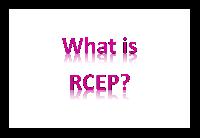
The Regional Comprehensive Economic Partnership (RCEP) is a proposed mega-regional Free Trade Agreement (FTA) between 16 Asia-Pacific countries including the 10-member ASEAN countries, China, Japan, India, South Korea, Australia and New Zealand.
Importance of RCEP
The RCEP, when realized will become the largest trade bloc in terms of population with nearly 3.5 billion people. It will also have an estimated 40% of world’s GDP and dominating 30% of global trade.
A unique importance of the ambitious RCEP formation is that it contains the three biggest economies of Asia – China, India and Japan. The trade arrangement has big future potential as it holds the two of the fastest growing largest economies – China and India.
Origin and objectives
The RCEP negotiations were launched at the Phnom Penh at a summit between the leaders of ASEAN and its six partners who occupies the remaining member of the RCEP on 20 November 2012.
Objective of RCEP negotiations is to “achieve a modern, comprehensive, high-quality and mutually beneficial economic partnership agreement among the ASEAN Member States and ASEAN’s FTA Partners. RCEP will cover trade in goods, trade in services, investment, economic and technical cooperation, intellectual property, competition, dispute settlement and other issues.” (from the Guiding Principles and Objectives for Negotiating the Regional Comprehensive Economic Partnership).
ASEAN centrality under RCEP
A leading feature about the RCEP is that it is proposed as a refined and unified version of the existing free trade arrangement that the ASEAN has with the six partners – China, Japan, India, South Korea, Australia and New Zealand. For the members of RCEP, already there is bilateral FTAs. But being just bilateral, they have different regulations, rules of origin requirements etc. A unified FTA will facilitate trade more.
Hence, the RCEP is modelled on FTAs of the ASEAN group with others and hence it is in an ASEAN+1 FTAs format. ASEAN +1 FTAs refers to the FTAs that ASEAN group have signed with each of the neighboring six countries – China, Japan, Korea, India, Australia and New Zealand.
Areas of RCEP negotiations
Interestingly, the RCEP’s trade agenda is quite broad as well as deep compared to large number of other trade arrangements. It covers the entry level trade liberalization effort on goods and widens to services though the extent of service trade engagement is keenly watched. At the same time, the RCEP makes negotiations on higher order liberalization issues like intellectual property rights, competition and ecommerce. The usual issues like investment and dispute settlement are also part of negotiations. In this context, the RCEP has a deep coverage matching to the several other West – bound RTBs.
Challenges in front of RCEP
Formation of the RCEP is not easy because of several economic and political hurdles. There are huge economic dissimilarities between the trading members. China is highly industrialized and is a trade powerhouse. India has more development objectives while connecting with trade. Japan and South Korea are innovation economies that excelled the world. Other ASEAN economies have long history of running FTAs though they are small in size.
Similarly, there is differences about the extent of trade liberalization. China want more commodities and higher tariff cuts. India on the other hand, prefers some restrictions as the country’s industrial sector is at the beginning state of development. Overall, most of the partners have a notion that China may dominate the RCEP because of its huge size economy and well competitive industrial sector advantages.
Politically, there is less synergy between the RCEP members in the context of unresolved territorial dispute of China with other members – Japan, China and some other East Asian economies.
*********









